Updated on January 5, 2023
Nowadays, prospects take more time to go through the sales funnel and eventually convert to customers. Although this means the sales process lasts longer, it does present an opportunity to implement multichannel prospecting in your sales by combining different channels such as email and LinkedIn to greater effect.
We’ll first take a look at some of the main strengths of both channels and then how you can combine them to provide your prospects with a more engaging selling experience.
The email as a main sales channel
Email outreach is the cornerstone of the sales process and the primary channel for reaching new customers. Due to its unbeatable ROI, you can be sure, that’s not about to change any time soon.
Email is an efficient and effective channel for sales. A versatile tool, that can be adapted to any multichannel outreach strategy, it allows sales representatives to personalize their messaging, scale their efforts and measure their approach based on reliable metrics.
Regardless of the task, a sales email can do it all. So what makes email outreach so great when it comes to sales prospecting and connecting with potential customers?
Benefits of email outreach
There are several key reasons why emailing is the most effective sales channel. In addition to being a widely used means for establishing a line of communication with potential customers, it is also a great delivery system for additional sales resources that can strengthen your relationship with a prospect like e-books, white papers, and guides to name a few of the main ones in B2B sales prospecting.
Making an introduction
Before making an offer and pitching to potential customers, you need to start the conversation of course. From a simple hello there to a more elaborate introduction with a prospect, a simple email to get the conversation started is often the first step.
The first impression is important, so make sure your first email is good so that you can begin building a new relationship with a prospect on a high note. Don’t go overboard with the details though, it’s about getting familiar not dumping on them a ton of information that can make them feel overwhelmed which can lead to them ghosting you and not bothering to reply.
Sharing valuable content
The more you know about your prospects, the easier your job will be. This also works for content. The better you understand your prospects, the easier it will be to help them solve their pain points. People like valuable content, that tells them how they can fix things and more importantly content that is actionable.
If they’re having troubles with email deliverability, send them a checklist they can easily follow to check their setup, or if they’re struggling to get a high open rate on their cold emails, then send them a piece with cold email subject lines they can use to increase their email opens.
The process is pretty straightforward since email is the perfect “trojan horse” that you can use to find out what’s bothering them and provide them with content to alleviate their problems, making their job easier.
Email outreach best practices for multichannel prospecting
While email outreach is a versatile channel and one that is quite malleable in terms of how a sales rep can use it and for which objectives, there are key areas that you need to be sure you do them properly.
Warm up your email
To ensure the success of your sales outreach, you need to ensure that your emails are being delivered into the recipient’s inbox instead of the spam folder. Warming up your email address improves your email sending reputation and email sending volume.
The email warm-up process essentially consists of sending a gradually increasing number of emails to other recipients and replying to their emails as well, signaling that your email address is active.
Find out more about how to warm up your email and how to do it with our email warm-up tool.
Create converting email templates
Another crucial step of your email outreach is having a good email template. This is important for scaling your sales efforts and engaging a higher number of prospects.
Of course, we’re not saying to send every prospect the same email, that is where email personalization comes into play, however email templates are a good way to streamline this part of the prospecting process. A structured approach helps to manage the level of personalization you’ll need and decide how to implement different information tags for each prospect.
Hyper-personalize your emails
You should personalize the emails you’re sending to your prospects with data you have on them to make your engagement better. Every part of the email can be personalized to an effect with dynamic tags. Include their name or even a potential pain point in the subject line, start the email with a powerful icebreaker that you can easily generate with our One-Liners tool.
In addition to the dynamic tags, it is also possible to personalize images and gifs for a more visual appeal. Email hyper-personalization is great if you want to break the ice and make your sales pitch to the prospects by sending them a tailored message.
A/B test your emails
The key to a successful email outreach is testing. To find out what works and what makes the prospect open your email you need to test different changes to your emails. Whether it’s a shorter subject line, a different icebreaker, or a better email template, the only way to find that out is through A/B testing.
LinkedIn as a social selling channel
While email reigns as the main sales channel, there is no question that social selling is following ever closely with over 80% of leads coming in from LinkedIn as the leading social selling platform for marketers and sales representatives.
With a large user base that keeps growing with a prospecting-focused filtering system and probably the most accurate and up-to-date user data as it is constantly user update, make LinkedIn the main social selling channel that the sales team must incorporate into their sales pipeline.
Benefits of using LinkedIn in sales
The system LinkedIn has in place allows for accurately targeting your audience and giving you several options for reaching out to them. Moreover, LinkedIn provides sales reps ways to connect with prospects and to start building that relationship through different types of engagement, messaging, and content.
Establishing a connection with prospects
To start the conversation on Linkedin, it is best to first connect with your prospect. Send them an invite to connect, and you can even write an accompanying message about why you want to add them to your network.
LinkedIn gives you the opportunity to connect with your target audience and potential customers so you can start building your relationship with them.
Building LinkedIn engagement
After you’ve connected with your prospect it is time to start building up a rapport with them. This can be done by initiating the conversation and creating engagement via different types of actions.
With Drip Campaigns you have several different types of LinkedIn actions available:
-
- Check if the profile connected
- Send a Connection Request
- Send Direct Message
- Like recent post
- View profile
With the help of the above LinkedIn actions, including following their company profile, like one of their posts and similar others, you can continue to nurture the connection you have with your prospects until they’re ready for the next step in your sales sequence.
LinkedIn best practices for multichannel prospecting
To successfully use LinkedIn in your sales outreach, there are some rules you should follow and things you can do to make the most of it. That means optimizing your Linkedin profile, preparing it for sales outreach, and personalizing the messages you’re sending to prospects.
Optimize your LinkedIn profile for selling
When it comes to prospecting on LinkedIn, you need to optimize your LinkedIn profile, because the prospects you want to connect with will want to see who you are and which company you work for.
To excel at social selling, you need to optimize different aspects of your LinkedIn profile. For example, you can use a professional profile image and a branded cover image to showcase your product.
Then you can include a value proposition in your headline and use the summary to elaborate on the headline with more details and accomplishments. Also, include useful sales materials such as e-books and white papers in your summary as well to reinforce your claims.
There are a lot more things you can do to properly optimize your LinkedIn profile for social selling, which will write about more in-depth later on.
Warm up your LinkedIn account
For a scalable sales outreach, it’s not just your email that needs to be warmed up, the same goes for your LinkedIn account as well. If you and your team are rapidly increasing their social selling and you haven’t built up enough engagement through your LinkedIn account there is a way you can quickly increase your LinkedIn activity and how many prospects you can reach on LinkedIn.
The LinkedIn warm-up process is similar to email warm-up. You’ll need to gradually raise the number of connections and LinkedIn messages while being careful not to go over the limit, which might get your LinkedIn account blocked, at least temporarily.
Personalize your LinkedIn messages
In contrast to email, LinkedIn messages or Inmails, have certain character limits that you need to be aware of. However you can make the most of those limitations by making your messages more focused, and besides that, you are still able to personalize your LinkedIn messages with dynamic tags as well as personalized images and gifs with Sales.Rocks to boost your reply and click-through rates.
The right sales tool for your sales
Sell more with Sales.Rocks
Number of touchpoints in B2B multichannel prospecting
In B2B sales, the sales cycle lasts longer and prospects require more time and multiple touchpoints to convert. This works in favor of multichannel prospecting, as it increases the importance of each of your channels, email, LinkedIn, and calling, enabling them to work together and set up a diverse sales cadence to drive higher conversion rates.
Automating your multichannel prospecting process is a must. It is impossible to set up and keep track of the different channels in your sales sequence without it, not to mention measuring prospect engagement and having your sales team on the same page. In this type of sales prospecting, the benefits of a sales enablement platform like Sales.Rocks are easier to see.
Combining email and LinkedIn for multichannel prospecting
There is a lot multichannel prospecting has to offer. Email outreach, LinkedIn, and calling are commonly the main channels sales teams rely on, for reaching out to and converting potential customers.
A combined sales sequence that incorporates all different channels in a way that they all work together, allows you to engage prospects on the channel they prefer. In doing so, it helps you increase the number of replies and booked meetings, and at the same time lower the chances of your prospect ghosting you and abandoning the conversation. The main benefits of using different channels together for prospecting are:
-
- Having better prospect engagement
- Tells prospects that you’ve done the research and took the time to connect with them via different platforms and channels in a unique way
- Results in better campaign performance, reply rates, and booked demos
- SDRs get a better understanding of the prospects’ preferred channel
Sales outreach template breakdown
You can combine email outreach and LinkedIn, adding calling as well, changing the order and purpose of the touchpoints in the sales sequence, depending on the goal of the campaign.
For instance, a typical outreach sequence for engaging new prospects begins with first visiting the prospect’s LinkedIn profile and sending them a LinkedIn connect request. A couple of days later follow up with an email and arrange a meeting.
You can also begin the sequence with a personalized cold email. Then you can send them a LinkedIn invite to connect and proceed with sending them a message on LinkedIn, to discuss the time of the following call.
How long the sequence will last, how many steps it has, and how you use the available channels depends entirely on your results. If your target audience responds more via email, or they prefer to engage on LinkedIn will tell you how your next campaign should be.
Setting up your prospecting outreach
As we mentioned previously, sales automation tools play a large part in setting up your sales outreach and making sure that you connect and engage with your prospects in an organized and efficient process. Now we’ll walk you through that exact process on Sales.Rocks, from start to finish.
Discovering and targeting the right prospects
The success of your prospecting, begins with finding and targeting the right audience. Ofcourse every sales team will agree that you need to keep the prospects coming in, as more prospects mean more potential customers and more revenue.
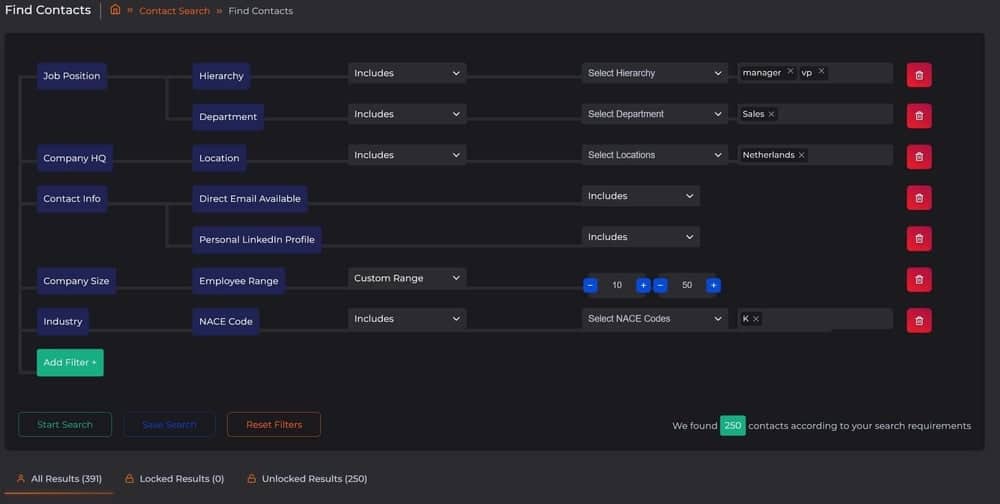
However, the main goal is not easting time going after prospects that have very little chance of converting. This can be easily done by better understanding who you should be reaching out to, otherwise, you’re setting yourself up for a low open rate and even lower conversion.
The solution is to have an Ideal Customer Profile ready and figure out with your sales team what type of prospects you need to contact.
Ideal customer profile
To better understand your best prospect match you can start by asking yourself the following questions:
-
- Where are the contacts located (niche region or country)?
- In which industry do they operate?
- Is the company a start-up, SME, or large corporation?
- What is their hierarchy structure?
- Targeted job position: What do they do on a daily basis?
- What might be their pain points?
- How does our product or service help them?
Finding their email address and LinkedIn
At this part of the multichannel process, finding your prospect’s email address and LinkedIn is a must. Usually, if you’re using a multichannel automation tool you’ll need to get the information from a business database then transfer the data if they have integration between the two support. We prefer to do it the easy way.
Using the different filters, we can quickly find the prospects you’re looking for together with their email and LinkedIn, as well as some additional information you can use to hyper-personalize your emails and LinkedIn message after a quick import from Company Search to Drip Campaigns. Pretty neat huh?
Creating your All-in-1 campaign
Now let’s take a look at how you can set up and run a multichannel campaign on the Sales.Rocks platform.
Step 1. First, make sure that your email and LinkedIn are connected and select how many prospects you want to engage on per day. If you’re connecting multiple LinkedIn accounts for outreach it’s a good idea to set up a LinkedIn proxy.
Note: Since we’re talking about using email and LinkedIn in our sequence, it is important to remember that are certain limits that apply to each channel respectively. We recommend you to reach out to 20 prospects per day via email and LinkedIn. Also, LinkedIn has a limit to the number of actions you can do in a day, which is around 100, after that LinkedIn might flag your account for review. Here’s more info on how to do LinkedIn outreach and not get blocked.
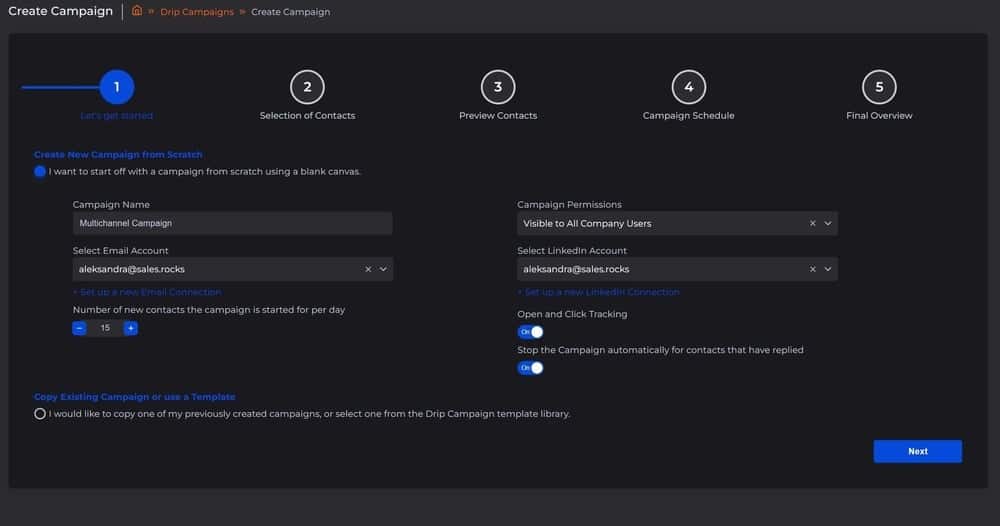
Step 2. Transfer a list of prospects that you want to include in your campaign or you can upload a file with your contacts just remember that you’ll need to map the data points you want to use for personalizing the emails and LinkedIn messages.
Bonus tip: If you are missing their LinkedIn URLs or other data, make sure you run your file on the Bulk Extractor as well and get your file fully enriched.
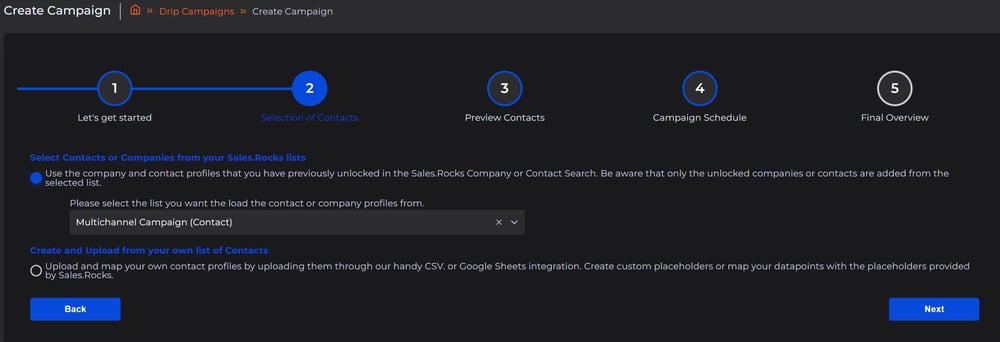
Step 3. Check the file to see if everything is in order and the email addresses and LinkedIn profiles along with the additional information you want to use is there.
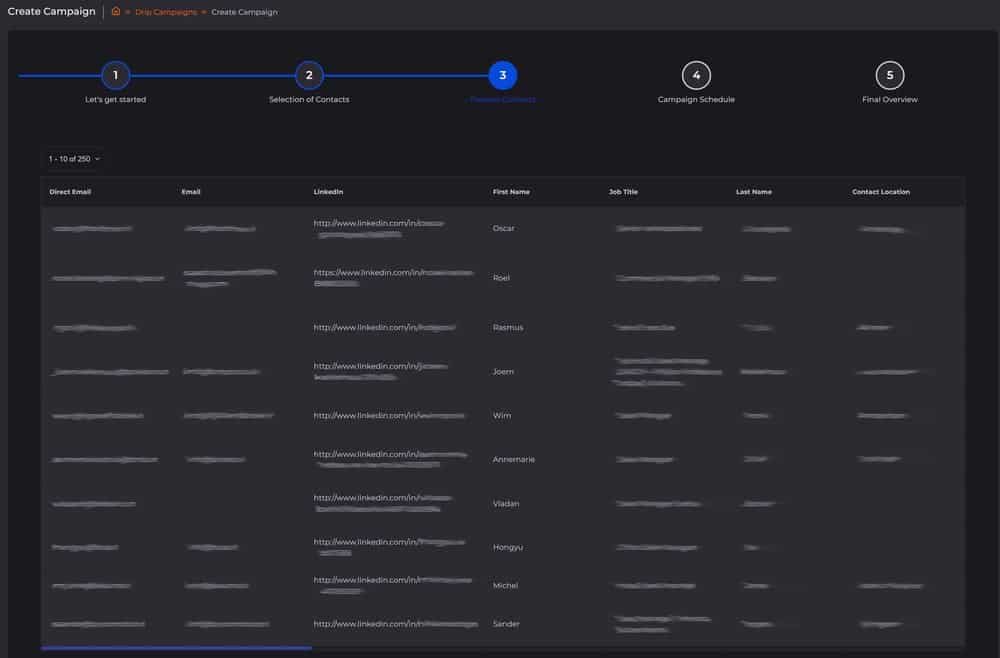
Step 4. Schedule the time when you want the campaign to run and when you want to start sending the emails, LinkedIn invites and perform the other LinkedIn actions.
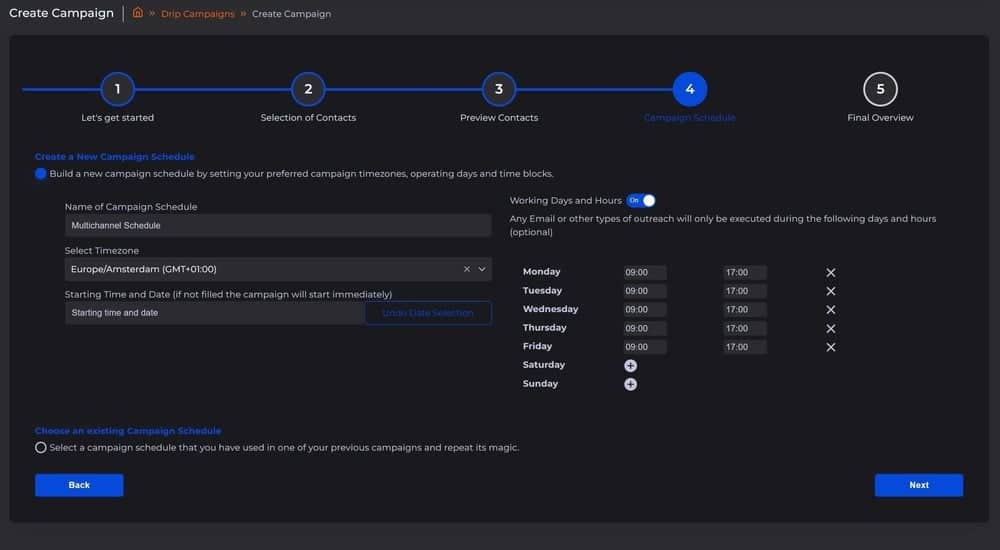
Step 5. Now comes the fun part, of creating and personalizing your campaigns’ email and LinkedIn messages templates and setting the triggers based on your prospects’ actions.
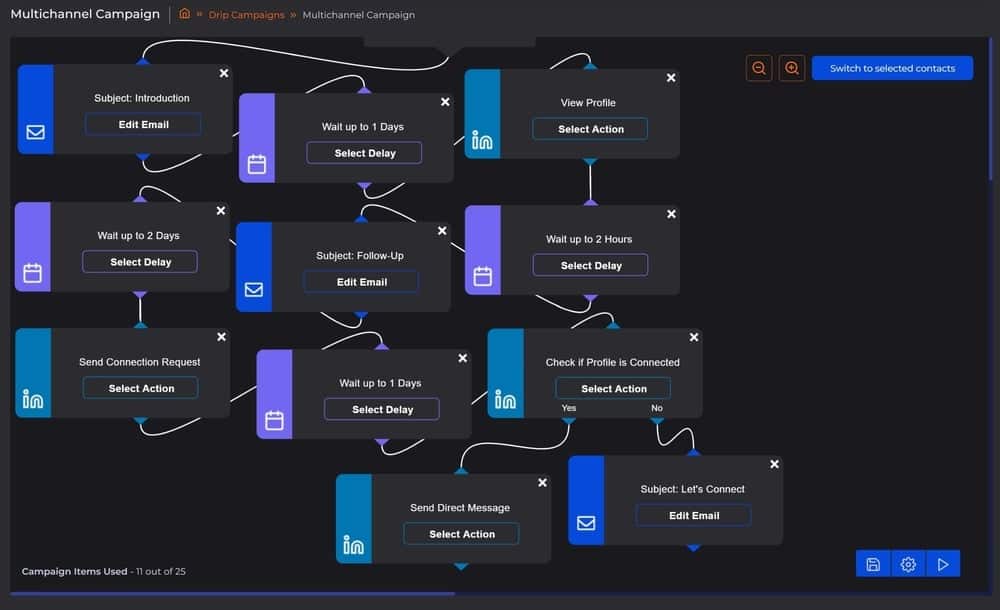
Our sales team recommends, scheduling your multichannel campaigns from the beginning of the week, so the steps can go smoothly throughout the week and you can measure results more accurately.
Sales outreach template example
Here’s a simple sales outreach template our sales team uses to begin the conversation with new prospects. Let’s break it down:
Day 1: First Email
Start off the conversation with a cold email to get the prospect interested in what you have to offer. The first impression the prospect gets about you and your company is important and personalization is key so they can see that you put in the effort and this is not just a generic introductory template.
Day 2: View Profile
Give them time to see and open the email before moving on with the sequence, but not too much time to forget you. One day is a good time delay for you to continue and build up interest by viewing their LinkedIn profile so the prospect knows that you’re in it for the long haul.
Day 2: Follow-up Email
A few hours delay after the previous action it’s time to send them a follow-up email, in case they missed the previous one. Reinforce the goal from the first email and if possible offer something extra, for example, a case study so they can see how you’ve helped other prospects dealing with challenges they might be facing.
Day 4: Send LinkedIn Connection Request
It’s time to send them a LinkedIn invite and connect with them. Sometimes is easier to connect with the prospect on LinkedIn, which is why an invitation to connect presents an opportunity to expand your outreach via a channel they feel more comfortable using.
Day 5: Check if Profile is Connected:
After another one-day delay, if they’re interested in your product or service and what you can offer, they’ll accept your connect invitation which means you’re in, and you can move forward with the conversation.
Day 5: Send Direct Message or Second Follow-up Email
Now you have two potential outcomes. Either they accepted your invitation to connect meaning you can send them a message on LinkedIn to arrange a meeting, or they’re still on the fence, not interested or they still haven’t seen your request. In that case, send them another follow-up email and come full circle back to the first point of contact, which was the email.
At this stage, you’ll know for sure where you stand and whether it’s worth it to continue chasing the prospects or not.
Conclusion
Multichannel prospecting might sound a bit complicated, but with the right tool, it can be a great way of reaching out to prospects and connecting with them through the channel they prefer, covering your bases and increasing your level of engagement.
Learn how to drive more sales


